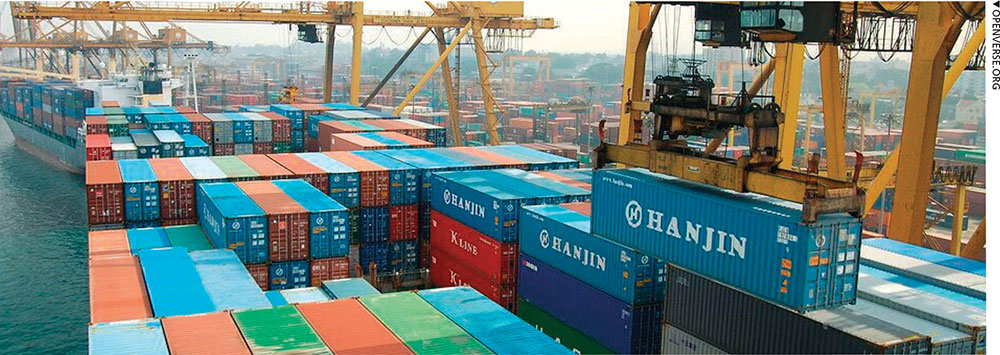A STRATEGIC INVESTMENT HUB
Sri Lanka’s export success and reforms may be setting the stage for growth

By leveraging its strengths in traditional and emerging industries, Sri Lanka can emerge as a strategic investment hub and drive sustainable growth.
Sri Lanka closed 2024 on an encouraging note, achieving its highest ever export revenue of US$ 16.1 billion. This milestone, reflecting a more than seven percent year-on-year growth, signals its potential to emerge as a significant player in the global export arena.
With plans to increase this inflow to 18.2 billion dollars this year, Sri Lanka is setting its sights on an ambitious long-term target of US$ 36 billion by 2030.
The export sector’s growth trajectory underscores a strategic focus on high value industries and presents a compelling opportunity for investors seeking to tap into Sri Lanka’s expanding markets.
Refreshingly, the 2024 export figures surpassed the previous high of US$ 15.7 billion recorded in 2018, showcasing resilience amid economic uncertainties across the world. This momentum is driven by a mix of traditional exports including apparel and tea, and emerging sectors such as technology and pharmaceuticals.
Sri Lanka’s geographic advantage as a maritime hub at the crossroads of Asia, Europe and the Middle East remains one of its most attractive features for investors.

The island’s proximity to key shipping routes enables businesses to efficiently access large consumer markets across multiple regions. This logistical edge, combined with the ongoing developments in port infrastructure, strengthens Sri Lanka’s position as a regional trade and investment hub.
The Colombo Port City project, designed to attract international financial and corporate investments, enhances Sri Lanka’s appeal.
Sri Lanka’s export growth is propelled by key industries, each offering distinct opportunities for investors.
The apparel and textile sector, which achieved revenues exceeding five billion dollars in 2024, continues to be a global leader in sustainable manufacturing practices. With innovations in eco-friendly fabric processing, the sector appeals to an increasingly conscious global market that values ethical production and sustainability.
Similarly, the tea industry – a cornerstone of Sri Lanka’s export portfolio – is evolving to cater to premium markets. By focussing on organic, single origin and specialty teas, exporters are tapping into growing the demand for high quality health conscious products.
Investors looking to align with this trend will find ample opportunities to capitalise on Sri Lanka’s reputation for excellence in tea production.
Emerging industries such as pharmaceuticals and technology also hold immense promise. The newly established pharmaceutical zone in Arabokka, Hambantota, is designed to cater to both local and export markets with favourable policies allowing investors to retain a portion of their output for domestic sales.
Similarly, the development of technology parks in Galle and Kurunegala reflects Sri Lanka’s commitment to fostering innovation and high value exports.
Sri Lanka’s strategic pivot towards value addition is a significant factor in enhancing its export potential even in traditional industries such as tea, rubber and coconut. Moving up the value chain ensures higher margins and greater competitiveness in world markets.
Innovation is another cornerstone of this strategy.
Industries across the board are embracing technology to optimise production processes, improve sustainability and create unique value propositions. From digitising supply chains in the apparel industry to developing renewable energy solutions, Sri Lanka is evolving into a hub for innovation driven exports.
Recognising the importance of creating a conducive environment for business, the government has embarked on a series of policy reforms. These measures include streamlining regulatory processes, improving infrastructure and offering tax incentives to attract foreign direct investments (FDI).
Simplified approval processes, reduced bureaucracy and a focus on transparency aim to make Sri Lanka a more attractive destination for investors. Furthermore, special economic zones and public-private partnerships (PPPs) are being leveraged to fast track industrial growth and export diversification.
The Asian Development Bank (ADB) has pledged its support for PPP investment opportunities in Sri Lanka, citing foreign investors’ enthusiasm for the country’s expanding prospects across multiple areas including climate change mitigation, agricultural modernisation and the energy sector.
Sri Lanka’s commitment to sustainability resonates with global market trends, making it a key differentiator in attracting investment. Industries are increasingly adopting eco-friendly practices to align with international standards and meet consumer expectations.
For instance, the apparel industry has established itself as a global leader in sustainable fashion while renewable energy projects are gaining traction as the nation works to reduce its carbon footprint.
Investors are increasingly prioritising markets that demonstrate a balance between profitability and environmental stewardship. Sri Lanka’s focus on integrating environmental, social and corporate governance (ESG) principles into its economic framework positions it as a forward thinking destination for sustainable investments.
While Sri Lanka’s export and investment potential is undeniable, challenges remain.
Regulatory bottlenecks, land allocation issues and infrastructure gaps need to be addressed to fully unlock the country’s capabilities. However, the proactive approach to reform and innovation offers hope that these barriers can be overcome.
As for investors, Sri Lanka represents a dynamic and evolving market. Its unique blend of geographic advantages, a diverse industry base and a focus on sustainability makes it a fertile ground for long-term growth.
